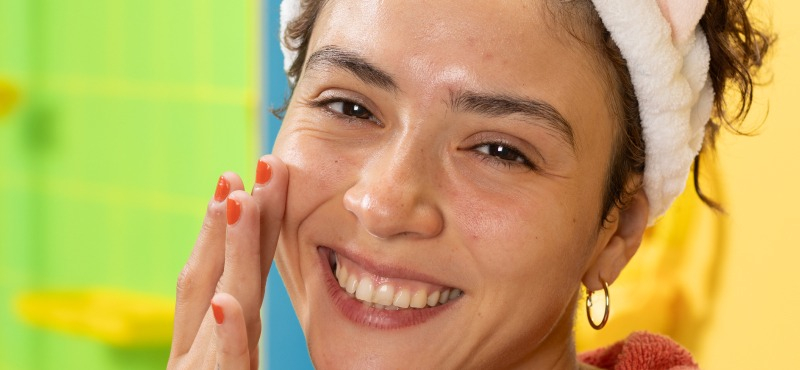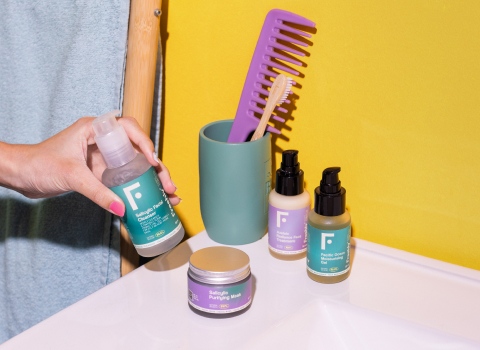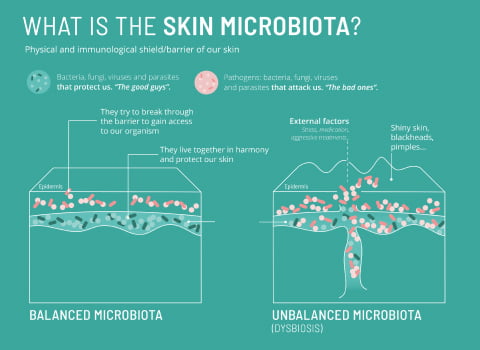Discover your microbiota and its relationship with acne. Your ally: salicylic acid. Do you know what it's for?

Here are your essentials
for making it this far
Do you have unwanted spots? Excess oil? Annoying pimples that appear in the most visible places at the most inopportune moments? Enlarged pores? Blackheads? Uneven complexion?... Do you have oily and acne-prone skin? Do you want to reduce its signs and improve the appearance of your skin? Then this article is of interest to you.
Why is my skin oily? Did you know that pimples are just the tip of the iceberg?
We know that being shiny or glowing in certain aspects of your life is something very positive that we all want, however your skin shines is not usually something you feel completely comfortable with, in addition, it is important to know that if the response of the skin is that (shine, blackheads, comedones, blackheads, open pores) is because it does not "feel good" and reacts, so beyond an aesthetic aspect we are talking about the health of our skin.
When our epidermis has excess oil is because something inside it is not working properly or has become unbalanced, we are talking about the microbiota, "the micro...what? "Did it sound more like something that had to do with our digestive system? well no, there is also the skin microbiota, all this has thrown you off? we know, do not worry, let's clear it up!
What is the microbiota and what does it have to do with acne and oily skin?
The skin microbiota is a complex ecosystem in which bacteria, fungi, viruses and parasites live together in harmony (like a happy family) to protect the skin as a physical and immunological barrier. Yes, these bacteria, fungi and viruses are on your skin and although it may surprise you, they are good for you! Let's take a practical example. We have the following elements:
- Strength - our body
- Warrior - our skin
- Shield/wall - the microbiota
- The good guys in the movie - bacteria, fungi, viruses and parasites
- The bad guys in the movie (villains) - pathogens
This combination of bacteria, fungi, viruses and parasites (the good guys) form a shield (or wall) to protect us from the pathogens (the villains or bad guys in the movie) that try to gain access to the inside of our body (fortress) through our skin (warrior) to "colonize" us and destabilize our health. If everyone maintains their positions, everything will work correctly to ensure that the bad guys (pathogens) do not gain access to the fortress (our body), therefore our health and that of our skin will not be altered.
But... there is always a "but", isn't there? Well this time it could not be otherwise, we are sorry but this shield or barrier (microbiota) can sometimes be destabilized or unbalanced and therefore does not get to protect us as it should.
Having explained this, it is also important to know that each person has a different microbiota, which is created harmoniously from the moment we are born, and which changes throughout our development, adapting to changes. This microbiota basically depends on our personal characteristics (sex, age, genes, diet, stress levels) and the environment that surrounds us (lifestyle, place where we live, sun exposure, domestic and personal hygiene...).
When this dysbiosis (imbalance of the microbiota) occurs, it is much more likely that the sebaceous glands that are used to generate a certain amount of sebum, the necessary for our body, begin to generate it in excess and we begin to see in our epidermis, shine, blackheads, comedones ... that end up generating signs of acne such as pimples or blackheads.
Let's talk about dysbiosis and excess sebum...
As we were saying, although everything is organized so that the microbiota functions correctly and adapts to changes, there are times when external factors such as stress, a change in lifestyle, the use of medications such as antibiotics or depending on which personal hygiene products or treatments, burst into our microbiota "like a bull in a china shop", destabilizing the balance of the microbiota. In these circumstances, certain bacteria that were beneficial to us take control of the skin and become pathogenic (the good guys change sides) or at least "allies or accomplices", allowing these pathogens to enter our body (strength). This is what is known as dysbiosis.
Salicylic acid, what is it used for?
This ingredient is widely used in cosmetic and dermatological products to reduce the signs of acne. There is a plant-based alternative that is obtained from the bark of the black willow tree and includes a high content of tannins and salicin, a natural source of salicylic acid. In the INCI (ingredient list) you’ll find this active ingredient under the name of Salix Nigra Bark Extract.
Benefits of salicylic acid for oily and acne-prone skin
Salicylic acid is the "ally of oily and acne-prone skin" because it has keratolytic and antimicrobial properties, what does this mean? This ingredient is capable of promoting skin desquamation, helping exfoliation and cell renewal, as well as fighting against contamination by bacteria and fungi that try to destabilize our microbiota. But that's not all, it also helps to reduce and regulate sebaceous secretion (Great! Because, as we were saying, there are times when the microbiota can become unbalanced and the sebaceous glands can start to secrete excess sebum), and there's more... It also acts as an anti-inflammatory. It has everything oily skin needs!

How to control excess oil?
A very important step for oily skin is facial cleansing in your daily routine. Cleansing the face is a way to reduce excess sebum, and to feel our skin fresher and less sticky. But not just any product will do, i.e. you can wash your face in the shower with water and gel for example, but... is it what your skin needs? The truth is that not everything will do! Precisely because most conventional gels are formulated with surfactants, sulphates and synthetic ingredients that may give the sensation of cleanliness but end up drying out the skin and deteriorating our microbiota (it could be the "a bull in a china shop" that we said before).
Therefore, it is very important to know what kind of products and ingredients are the most suitable and beneficial for oily and/or acne-prone skin.
How does salicylic acid help balance our microbiota and reduce oil and acne?
This ingredient has the ability to reduce the presence of microorganisms, bacteria and fungi (it can stop that "elephant in the china shop" we were talking about earlier) that cause infections or skin disorders such as acne. How? It prevents their proliferation or growth on the skin, thus maintaining the balance of the microbiota. But as we mentioned before, it also has other very interesting benefits for oily and/or acne-prone skin, because it also exfoliates, is anti-inflammatory and reduces excess oil. And if we take into account what this ingredient achieves and compare it with the 4 main factors that cause acne:
- Excess sebum production
- Hair follicles clogged by oily matter and dead skin cells
- Inflammation
- Bacteria
We can clearly see that it addresses the main concerns of oily and acne-prone skin, making it a must-have star ingredient in your skincare cleanser. Definitely an ally, don’t you think?

How to control excess oil and acne signs? Include in your routine these two steps: cleanser and mask with salicylic acid
A crucial step for oily skin is facial cleansing daily. Cleansing is a way to reduce excess sebum, and to feel our skin fresher and less sticky. Pay close attention to which product you choose, though. For example, you can wash your face in the shower with water and gel for example, but... Is that what your skin needs? The answer is no, it’s not. Remember, not everything works! Most gels contain in fact surfactants and sulfates, that may give a feeling of cleanliness, but ultimately end up drying out the skin and deteriorating our microbiota (it could be the “bull in a china shop” we were talking about before).
Therefore, having a natural cleanser with plant-derived salicylic acid can help you. Another way to complete the routine for oily and/or acne-prone skin is to add a mask (once or twice a week) that also, in its formula, contains plant-derived salicylic acid, to rebalance your microbiota and keep unwanted shine and pimples at bay.
Freshly wants to tell you something! At Freshly we keep on learning every day how to make decisions that bring us closer to a better future. Sometimes we are called dreamers, but what we really have is an optimistic vision and clear path for reaching that tomorrow.
Would you like to join this adventure? If you're here, it's because you are a demanding person when it comes to taking care of your body and the planet. By subscribing to the newsletteryou will receive articles like this one to continue learning, as well as news and exclusive discounts. Are you up for it?




